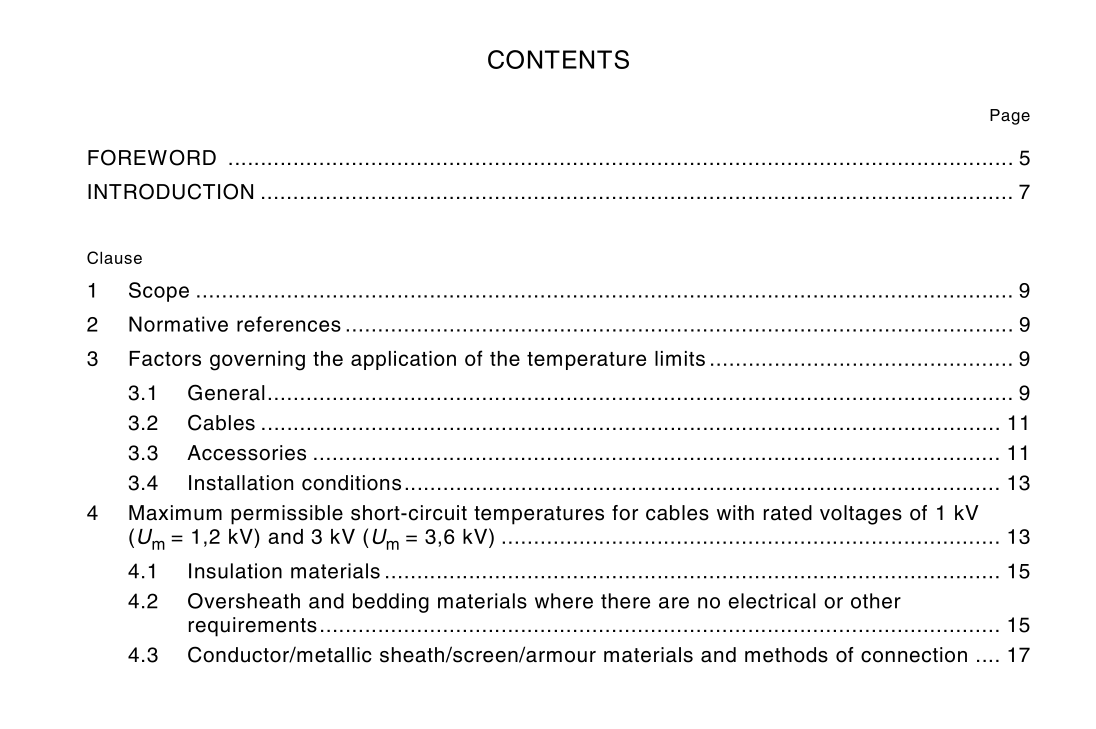IEC 60724 pdf download

IEC 60724 pdf download.Short-circuit temperature limits of electric cables with rated voltages of 1 kV ( U m = 1,2 kV) and 3 kV ( U m = 3,6 kV)
1 Scope
This International Standard gives guidance on the short-circuit maximum temperature limits of electric cables having rated voltages of 1 kV ( U m = 1,2 kV) and 3 kV ( U m = 3,6 kV), with regard to the following: – insulating materials; – oversheath and bedding materials; – conductor and metallic sheath materials and methods of connection. The design of accessories and the influence of the installation conditions on the temperature limits are taken into consideration. The calculation of the permissible short-circuit current in the current-carrying components of the cable should be carried out in accordance with IEC 60949.
2 Normative references
The following normative documents contain provisions which, through reference in this text, constitute provisions of this International Standard. For dated references, subsequent amendments to, or revisions of, any of these publications do not apply. However, parties to agreements based on this International Standard are encouraged to investigate the possibility of applying the most recent editions of the normative documents indicated below. For undated references, the latest edition of the normative document referred to applies. Members of IEC and ISO maintain registers of currently valid International Standards. IEC 60055 (all parts), Paper-insulated metal-sheathed cables for rated voltages up to 18/30 kV (with copper or aluminium conductors and excluding gas-pressure and oil-filled cables) IEC 60502-1:1998, Power cables with extruded insulation and their accessories for rated voltages from 1 kV (U m = 1,2 kV) up to 30 kV (U m = 36 kV) – Part 1: Cables for rated voltages of 1 kV (U m = 1,2 kV) and 3 kV (U m = 3,6 kV) IEC 60949:1988, Calculation of thermally permissible short-circuit current, taking into account the non-adiabatic heating effects
3 Factors governing the application of the temperature limits
3.1 General The short-circuit temperatures given in clause 4 are the actual temperatures of the current- carrying component as limited by the adjacent material in the cable and are valid for short- circuit durations of up to 5 s. When calculating the allowable short-circuit current, these temperatures will be obtained if heat loss into the insulation during the short-circuit is taken into account (non-adiabatic heating). If heat loss during the short-circuit is neglected (adiabatic heating), the calculations give short-circuit currents that are on the safe side. NOTE The temperature limits given in clause 4 should also not be exceeded with repeated short-circuits occurring in a short time.The 5 s time period mentioned is the limit for the temperatures quoted to be valid and not for the application of the adiabatic calculation method. The time limit for the use of the adiabatic method has a different definition, being a function of both the short-circuit duration and the cross-sectional area of the current-carrying component. This is dealt with in IEC 60949. Caution may be needed when using the conductor temperatures specified when the cables are sheathed with a lower temperature material, especially for cables with conductor cross- sectional areas of 1 000 mm 2 and above. This is because the high thermal time constant of these cables will cause the oversheath to attain high temperatures for longer times. In addition, the high mechanical forces could result in insulation deformation. Nevertheless, it should be stressed that for conductor cross-sectional areas above 1 000 mm 2 the permissible short- circuit current is so high that it is not normally attained in common systems. Where other temperature limits are known with certainty to be more appropriate for the materials or the cable design, then these may be used.3.2 Cables 3.2.1 Paper insulated cables (mass-impregnated cables according to IEC 60055) The temperature limits for paper insulated cables impregnated with oil/resin or non-draining compound are imposed by the tendency to compound migration and void formations. All paper insulated cables are also limited by thermal degradation of the cable components and by possible tearing of paper tapes due to movement of the cores. 3.2.2 Polymeric insulated cables (according to IEC 60502-1) For thermoplastic insulating materials, the temperature limits should be applied with caution when the cables are either directly buried or securely clamped when in air. Local pressure due to clamping or the use of an installation radius less than that specified for the cable, especially for cables that are rigidly restrained, can lead to high deforming forces under short-circuit conditions. Where these conditions cannot be avoided it is suggested that the limit be reduced by 10 °C.









